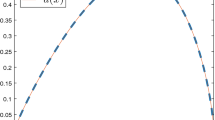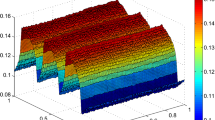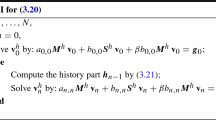Abstract
In this paper, we decompose the fractional derivative space as the direct-sum of a fractional Sobolev space and a singular space spanned by \(x^{-\beta }\) and then propose a \(x^{-\beta }\)-independent mixed type variational formulation over the commonly used Sobolev spaces for a kind of variable-coefficient fractional diffusion equations, based on the least-squared techniques and the merits of the direct-sum decomposition. We then prove the existence and uniqueness of the variational formulation, show the equivalence between the variational formulation and the fractional diffusion equation and discuss the regularity of the solution to the equation with a general right hand side function. As a consequence, an easily-computed and optimal-order-convergent least-squared mixed finite element method is established. The optimal-order numerical analysis with supporting numerical experiments is also conducted.
Similar content being viewed by others
References
Askey, R., Fitch, J.: Integral representations for Jacobi polynomials and some applications. J. Math. Anal. Appl. 26(2), 411–437 (1969)
Benson, D.A., Wheatcraft, S.W., Meerschaert, M.M.: The fractional-order governing equation of L\(\acute{e}\)vy motion. Water Resour. Res. 36, 1413–1423 (2000)
Brenner, S.C., Scott, L.R.: The Mathematical Theory of Finite Element Methods. Springer, New York (1994)
Chen, H.Z., Wang, H.: Numerical simulation for conservative fractional diffusion equations by an expanded mixed formulation. J. Comp. Appl. Math. 296, 480–498 (2016)
Ciarlet, P.G.: The Finite Element Method for Elliptic Problems. North-Holland, Amsterdam (1978)
Deng, W., Hesthaven, J.S.: Local discontinuous Galerkin methods for fractional diffusion equations. ESAIM Math. Model. Numer. Anal. 47, 1845–1864 (2013)
Donatelli, M., Mazza, M., Serra-Capizzano, S.: Spectral analysis and structure preserving preconditioners for fractional diffusion equations. J. Comput. Phys. 307, 262–279 (2016)
Ervin, V.J., Heuer, N., Roop, J.P.: Regularity of the solution to 1-D fractional order diffusion equations. Math. Comput. 87, 2273–2294 (2016)
Ervin, V.J., Roop, J.P.: Variational formulation for the stationary fractional advection dispersion equation. Numer. Methods Partial Differ. Equ. 22, 558–576 (2005)
Ervin, V.J., Roop, J.P.: Variational solution of fractional advection dispersion equations on bounded domains in \(R^d\). Numer. Methods Partial Differ. Equ. 23, 256–281 (2007)
Fix, G.J., Roop, J.P.: Least squares finite-element solution of a fractional order two-point boundary value problem. Comput. Math. Appl. 48, 1017–1033 (2004)
Gorenflo, R., Fabritiis, G.D., Mainardi, F.: Discrete random walk models for symmetric Levy-Feller diffusion processes. Phys. A. 269, 79–89 (1999)
Grisvard, P.: Elliptic Problems in Nonsmooth Domains. Pitman, Boston (1985)
Jia, J.H., Wang, H.: A preconditioned fast finite volume scheme for a fractional differential equation discretized on a locally refined composite mesh. J. Comput. Phys. 299(15), 842–862 (2015)
Jia, L.L., Chen, H.Z., Wang, H.: Mixed-type Galerkin variational principle and numerical simulation for a generalized nonlocal elastic model. J. Sci. Comput. 71, 660–681 (2017)
Jin, B.T., Lazarov, R., Pasciak, J., Rundell, W.: Variational formulation of problems involving fractional order differential operators. Math. Comput. 84, 2665–2700 (2015)
Jin, B.T., Lazarov, R., Zhou, Z.: A Petrov–Galerkin finite element method for fractional convection-diffusion equations. SIAM J. Numer. Anal. 54, 481–503 (2016)
Jin, B.T., Lazarov, R., Lu, X.L., Zhou, Z.: A simple finite element method for boundary value problems with a Riemann-Liouville derivative. J. Comput. Appl. Math. 293, 94–111 (2016)
Jin, B.T., Zhou, Z.: A finite element method with singularity reconstruction for fractional boundary value problems. ESAIM Math. Model. Numer. Anal. 49, 1261–1283 (2015)
Klafter, J., Sokolov, I.M.: Anomalous diffusion spreads its wings. Phys. World. 18(8), 29–32 (2005)
Lei, S.L., Sun, H.W.: A circulant preconditioner for fractional diffusion equations. J. Comput. Phys. 242, 715–725 (2013)
Li, Y.S., Chen, H.Z., Wang, H.: A mixed-type Galerkin variational formulation and fast algorithms for variable-coefficient fractional diffusion equations. Math. Method Appl. Sci. 40, 5018–5034 (2017)
Lions, J.L., Magenes, E.: Non-homogeneous Boundary Value Problems and Applications, vol. I. Springer, New York (1972)
Mao, Z.P., Chen, S., Shen, J.: Efficient and accurate spectral method using generalized Jacobi functions for solving Riesz fractional differential equations. Appl. Numer. Math. 106, 165–181 (2016)
Meerschaert, M.M., Tadjeran, C.: Finite difference approximation for two-sided space-fractional partial differential equations. J. Appl. Math. 56, 80–90 (2006)
Nie, N., Huang, J., Wang, W., Tang, Y.: Solving spatial-fractional partial differential diffusion equations by spectral method. J. Stat. Comput. Simul. 84, 1173–1189 (2014)
Pan, J., Ng, M.K., Wang, H.: Fast iterative solvers for linear systems arising from time-dependent space-fractional diffusion equations. SIAM J. Sci. Comput. 38(5), A2806–A2826 (2016)
Pang, H.K., Sun, H.W.: Multigrid method for fractional diffusion equations. J. Comput. Phys. 231, 693–703 (2012)
Podlubny, I.: Fractional Differential Equations. Academic Press, New York (1999)
Samko, S., Kilbas, A., Marichev, O.: Fractional Integrals and Derivatives: Theory and Applications. Gordon and Breach, London (1993)
Scher, H.E., Montroll, W.: Anomalous transit-time dispersion in amorphous solids. Phys. Rev. B. 12(6), 2455–2477 (1975)
Shen, J., Tang, T., Wang, L.L.: Spectral Methods: Algorithms, Analysis and Applications. Springer, Berlin (2011)
Sobolev, R.A., Fournier, J.F.: Sobolev Spaces. Elsevier, Singapore (2009)
Szego, G.: Orthogonal Polynomials. American Mathematical Society Colloquium Publications, vol. 23. American Mathematical Society, Providence (1975)
Wang, H., Basu, T.S.: A fast finite difference method for two-dimensional space-fractional diffusion equations. SIAM J. Sci. Comput. 34, A2444–A2458 (2012)
Wang, H., Yang, D.P.: Wellposedness of variable-coefficient conservative fractional elliptic differential equations. SIAM J. Numer. Anal. 51(2), 1088–1107 (2013)
Wang, H., Yang, D.P., Zhu, S.F.: A Petrov–Galerkin finite element method for variable-coefficient fractional diffusion equations. Comput. Methods Appl. Mech. Eng. 290, 45–56 (2015)
Wheatcraft, S.W., Meerschaert, M.M.: Fractional conservation of mass. Adv. Water. Resour. 31, 1377–1381 (2008)
Yang, D. P., Wang, H.: Wellposedness and regularity of steady-state two-sided variable-coefficient conservative space-fractional diffusion equations. arXiv:1606.04912 [math.NA] (2016)
Yang, Q., Turner, I., Moroney, T., Liu, F.: A finite volume scheme with preconditioned Lanczos method for two-dimensional space-fractional reaction-diffusion equations. Appl. Math. Model. 38, 3755–3762 (2014)
Zhang, Y., Benson, D.A., Meerschaert, M.M., Scheffler, H.P.: On using random walks to solve the space-fractional advection-dispersion equations. J. Stat. Phys. 123, 89–110 (2006)
Acknowledgements
The authors thank sincerely the anonymous referees for their valuable suggestions which highly improve the quality of this article.
Author information
Authors and Affiliations
Corresponding author
Additional information
This work is supported in part by the National Natural Science Foundation of Grant Nos.11471196, 11471194, 10971254, 11301311, 91130010, 11571115, 11171193 and by the National Science Foundation under Grant Nos. EAR-0934747and DMS-1216923 and by the OSD/ARO MURI Grant Nos. W911NF-15-1-0562.
Appendix
Appendix
In this appendix, we first introduce the definitions and notations of the negative fractional spaces and their relations, and then prove the \(H^{\gamma -\beta }(\varOmega )\)-regularity of \(x^{-\beta }\), which is used in the second assertion of Theorem 3.4.
Definition 6.1
(Negative fractional derivative space [4, 6]) For any \(\beta \ge 0\), define space \(J_{L}^{-\beta }(\varOmega )\) as the closure of \(C_0^\infty (\varOmega )\) with respect to the norm \(\Vert \cdot \Vert _{J_{L}^{-\beta }(\varOmega )}\), defined by
Definition 6.2
(Negative Sobolev space [13, 23]) For any \(\beta \ge 0\), define space \(H^{-\beta }(\varOmega )\) as the dual space of \(H_0^{\beta }(\varOmega )\).
Lemma 6.1
([4]) For any \(\beta \ge 0\), \(\beta \ne n-\frac{1}{2}\) with \(n\in \mathbb {N}\). Then, the negative fractional derivative space \(J_{L}^{-\beta }(\varOmega )\) and the negative fractional Sobolev space \(H^{-\beta }(\varOmega )\) are equal with equivalent norms.
Now we give the main lemma.
Lemma 6.2
Assume that \(0\le \beta \le 1.\) Then, there exists a real number \(\gamma \) (\(0<\gamma <{1\over 2}\)), which can be selected as close as possible to \(1\over 2\), such that \(x^{-\beta }\in H^{\gamma -\beta }(\varOmega ).\)
Proof
We consider two cases for \(\beta \).
Case (1). As \(0\le \beta <\frac{1}{2}\).
Recalling the definition of fractional Sobolev spaces [23, 33], we know that the norm of \(\mathbf{v}\in H^s(\varOmega )\) for \(0\le s<1\) is defined by
Apparently, \(x^{-\beta } \in L^2(\varOmega )\) for \(0\le \beta <{1\over 2},\) then, it suffices to show that the singular integral in (6.1) is finite to draw the conclusion of \(x^{-\beta }\in H^s(\varOmega ).\)
For this purpose, we decompose the integral into two parts:
For \(I_1\), applying the mean value theorem of differentials, changing variables from x to t, then to \(\eta ,\) and tediously calculating, we yield
where \(\theta \in (0,1)\) is a mean value constant. Denoting \(z=1-\theta ,\) we find that the inner singular integral is closely related to the well-known Gauss hypergeometric function \({_2F_1}(a,b,c;z)\) with \(a=2-2\beta ,b=2-2s,c=3-2\beta -2s\) and \( z=1-\theta ,\) expressed by [30],
The Gauss hypergeometric function \({_2F_1}(a,b,c;z)\) is convergent since \(0<b<c\) and \(0<z<1,\) and thus the inner singular integral in \(I_1\). As a consequence of the convergence of \({_2F_1}(a,b,c;z)\) , \(I_1\) is finite if and only if \(\int _0^1\frac{1}{y^{2s+2\beta }}dy\) is convergent, which implies equivalently that \(2(s+\beta )<1\) or \(s<\frac{1}{2}-\beta \).
A similar calculation for \(I_2\) shows that
In the last step, the conditions \(0<1-y<1\) and that the integrand is non-negative are used. Analogous to \(I_1\), we involve the inner singular integral in \(I_2\) into the convergent Gauss hypergeometric function \({_2F_1}(a,b,c;z),\)
with \(a=2-2\beta ,b=2-2s,c=2\) and \(z=1-\theta .\) So, the finiteness of \(I_2\) is equivalent to requiring \(s<\frac{1}{2}-\beta .\)
Collecting the finiteness of \(I_1\) and \(I_2\), we conclude that \(\Vert x^{-\beta }\Vert _{H^s(\varOmega )}\) is finite for \(s<{1\over 2}-\beta \). Taking \(s=\gamma -\beta \), we obtain the stated result.
Case (2). As \(\frac{1}{2}\le \beta <1\).
In this case \(\beta -\gamma >0\). The fact \(_0I_x^{\beta -\gamma }x^{-\beta }=\frac{\varGamma (1-\beta )}{\varGamma (1-\gamma )}x^{-\gamma }\in L^2(\varOmega )\) implies \(x^{-\beta }\in J_L^{-(\beta -\gamma )}\). Considering the equivalence between space \(J_L^{-(\beta -\gamma )}(\varOmega )\) and space \(H^{-(\beta -\gamma )}(\varOmega )\) (see Lemma 6.1), we obtain the result. \(\square \)
Rights and permissions
About this article
Cite this article
Yang, S., Chen, H. & Wang, H. Least-Squared Mixed Variational Formulation Based on Space Decomposition for a Kind of Variable-Coefficient Fractional Diffusion Problems. J Sci Comput 78, 687–709 (2019). https://doi.org/10.1007/s10915-018-0782-y
Received:
Revised:
Accepted:
Published:
Issue Date:
DOI: https://doi.org/10.1007/s10915-018-0782-y
Keywords
- Variable-coefficient
- Fractional diffusion equation
- Direct-sum decomposition
- Fractional derivative space
- Least-squared technique
- Variational formulation
- Mixed finite element methods
- Convergence analysis




